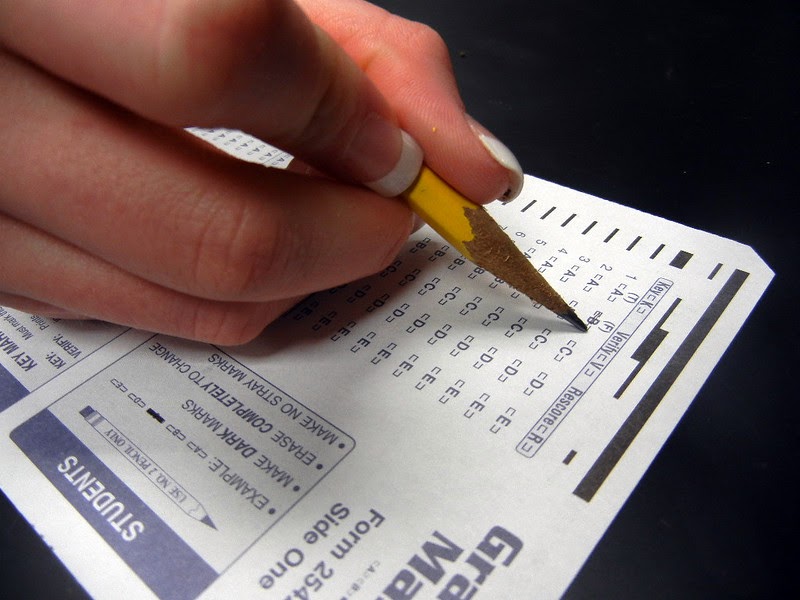Should Schools Require the SAT?
“Standardized Test Close-Up” by biologycorner is licensed under CC BY-NC 2.0
Any student applying to college has heard of the SAT, a three-hour test designed to measure the student’s readiness for college. The complex history of the SAT dates back to 1926 when it was originally created with the intention of measuring the intelligence of applicants. However, there was a significant flaw in the original SAT: it was unfair to marginalized communities because it only used one dialect of English that more affluent communities spoke. Even today, over 90 years later, the SAT’s fairness is still brought into question. Does it really guarantee “equality of opportunity” to everyone?
One of the key stressors on the SAT is that it is a timed test. Under normal testing circumstances, participants have three hours to complete four sections: 65 minutes on Reading, 35 on Language and Writing, and 80 minutes on Math. For those with diagnosed learning disabilities, College Board, the company that administers the SAT, may grant extended time. The amount of time students receive can mean the difference between completing the test or not. According to an article from the Wall Street Journal studying the distribution of extended time by class, 2.8% of students from public schools received accommodations while 4.2% received accommodations at wealthy schools. This percentage was even lower in poor schools, where those with extended testing time make up just 1.6% of students. In theory, these numbers should be equal- background doesn’t affect whether a student is born with learning differences or not. However, the data suggests a correlation between social class and opportunities; namely, students from wealthier backgrounds have a higher chance of being granted extended time. Understandably, this caused a lot of backlash and sparked numerous debates over the fairness of the SAT.
The element of “fairness” was again called into question in 2019 by the highly-publicized “College Admission Scandal.” According to newsite, The Insider, The scandal involved 53 wealthy families, including business people and actors, who were accused of bribery and fraud to gain admission to top colleges. Among others, some of the charges alleged that families paid SAT-experts to pose as their children and take tests for them or change the answers after they were finished. Many of these families obtained extended-testing time for their children, even when it wasn’t necessary. This raised the question of whether college admissions is a “pay-to-play game” and if wealthier families have an advantage.
Equal opportunity has always been a debate when it comes to school admissions, and the SAT is no exception. SAT scores show a worrying trend: the higher a student’s average income, the higher their performance on the test. Minorities perform the worst of any other group on the SAT. This isn’t due to lack of intelligence, but simply relatively less academic support, suggesting that a student’s score is affected by their socioeconomic status rather than their intelligence and the SAT fails at achieving its goal.
But why do students from underprivileged backgrounds perform worse than their rich counterparts? They often don’t have the same access to opportunities that students from wealthier families do, such as tutoring, extra books to prepare, and smaller class sizes. According to data from the Brookings Institute, students whose household income is greater than $200,000 outscore students whose household income is less than $20,000 by almost 200 points in both the math and reading section of the test. Poorer students are more likely to work jobs outside of school leaving them less time to prepare for the SAT. By all accounts, the odds are against them even before they take the test.
With over 2 million students taking the SAT each year, there’s an industry specifically for SAT materials, including SAT preparation books and practice materials. However, these materials come at a cost; SAT preparation books can cost upwards of 20 dollars. As a two-time test taker of the SAT, I’ve witnessed the difference that more preparation can make. I felt that the materials I used to study made a huge difference in my score and made me feel more confident. But students who don’t have access to the same kind of materials are forced to rely on their own knowledge with limited background on the test. The SAT’s purpose is to cover high school content, but not all schools teach the same content. Most schools don’t teach content specifically for the SAT, which makes test-prep books all the more valuable because they cover material that is specific to the test.
As a current senior and college hopeful, I don’t feel like the SAT shows the true value of my qualities as a student. My main issue with the SAT is that schools have no idea what emotions or events led to my performance on the test, they only see the raw score. If colleges are comparing students only by scores, it dehumanizes the student. I feel like my college essays and transcript paint a much better picture of who I am as a person: my interests, my talents and my weak spots because they’re more personalized. In other words, two students might have the same score, but no two essays will be the same.
Although standardized testing is still the norm, notable changes are being made to the college testing process. Due to the COVID-19 pandemic, many students were unable to take standardized tests, such as the SAT, because of testing center closures or safety concerns. Because of this, many colleges and universities stopped requiring students to submit their test scores. Top colleges, including Columbia, Harvard, NYU, and Stanford, became test-optional for the 2021 application cycle. But for some schools, such as the UC’s, this change is becoming permanent. The UC’s are now “test-blind”: they don’t accept or consider an applicant’s test scores when evaluating their entire profile. But they’re not alone. Other schools have started following in the UC’s footsteps and going test-blind or test-optional. For a lot of students, including myself, this is a welcome change. Clearly, we’re starting to see a shift in the college admissions process that is phasing out standardized testing in favor of transcripts and activities only.






